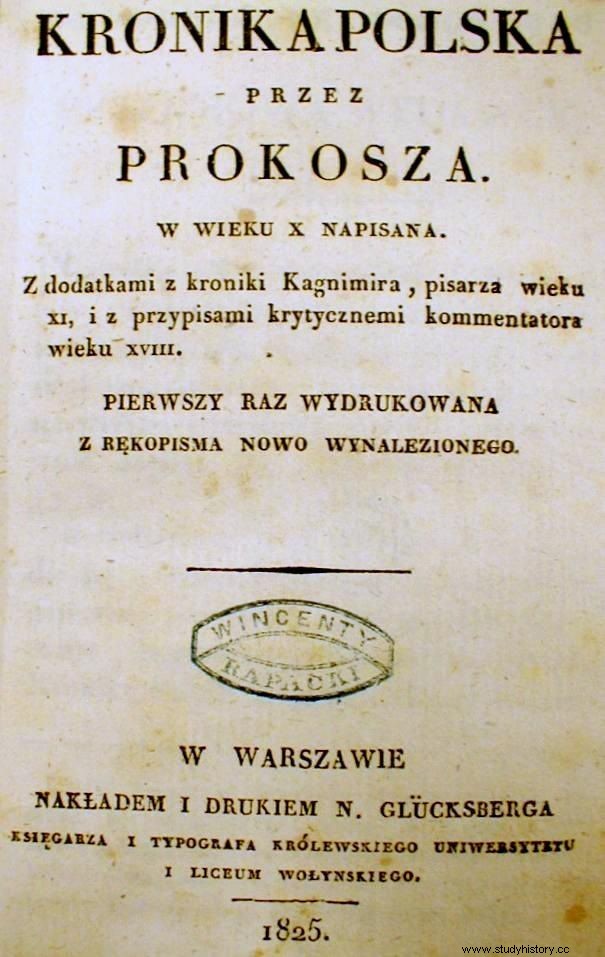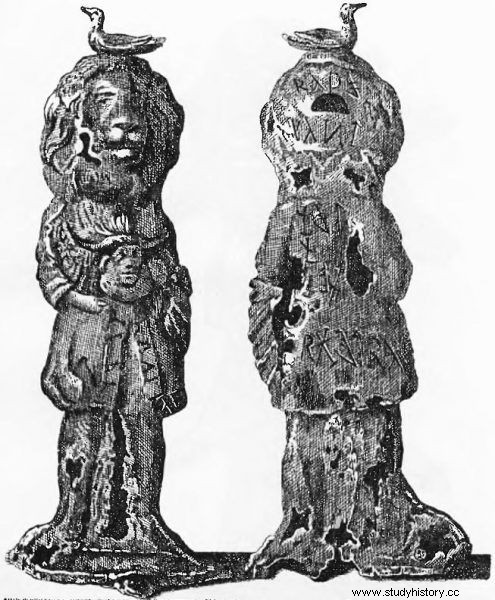Based on fakes, fakes and hoaxes, it is easy to create an additional several thousand years of the alleged, glorious history of Poland. And this is what turbolechite theories are based on:completely fictional materials.
In his new book on Slavic beliefs before Christianization ( Religions of the ancient Slavs , Wydawnictwo Poznańskie 2018), an outstanding medievalist, Dr. hab. Dariusz A. Sikorski lists a whole lot of sources that were completely misunderstood or which are nothing more than fakes.
It is on them, among others, that the supporters of the Great Lechia build their visions of history:dilettantes convinced that there is an international conspiracy to hide the truth about Polish history. The truth according to which the Polish power allegedly existed for thousands of years, our rulers clashed with Alexander of Macedon on the Balkan border, and the culture of the Slavs surpassed the neighboring ones in every respect ...
Below are some examples of sources and "evidence" that no serious historian takes seriously. But which amateurs can confuse them quite well.
The Chronicle of Prokosz
The Turboslavic Bible, allegedly confirming all their boisterous claims. This chronicle was first published in print in 1825. It was supposed to be an authentic book, written already in the 10th century by the Archbishop of Kraków, Prohor, with the Slavic name of Prokosz.
"For many Polish historians of the 19th century, Prokosz's Chronicle it was like a revelation ”- emphasizes Dariusz A. Sikorski. - "It opened a window to the world of the oldest and completely unknown area of Polish history." Even the famous Julian Ursyn Niemcewicz believed in its content. However, when the search for the original work was started, not even a fake sewn with thick threads was revealed, but ... a simple joke.

Title page of the first edition of the Chronicle of Prokosz from 1825
Already in the nineteenth century it was established beyond any doubt that the chronicle was only a fake, created no later than in the middle of the previous century. Its content was no longer taken seriously and no longer used for any research. Today we know even more. In 2004, the medievalist from the University of Silesia, Piotr Boroń, showed that Kronika Prokosza wrote, and only for fun, by General Franciszek Morawski - a writer who died in 1861.
As Dariusz A. Sikorski explains in the pages of Religions of the Old Slavs :"[Morawski] did not foresee that no one would recognize each other by joking and would be taken seriously." All the more, he could not have foreseen that a century and a half later, pseudo-historians would build careers on pseudo-analysis of his frivolous scribes ...
Prillwickie idols
Around 1760, the news spread through Germany about mysterious figurines that had been reportedly dug several decades earlier by a simple pastor from the village of Prillwitz in Mecklenburg. Initially, it was said that there were about fifty of the finds. Then, as is often the case with all kinds of forgery, the number of artefacts increased to a hundred.

Religion of the old Slavs without fabrications, manipulations and simplifications. Interpretation of an outstanding specialist shedding new light on the topic is already on sale.
They were small bronze idols with peculiar inscriptions resembling runes. Not only were these signs "decoded", but also based on them, it was proved that the figures come from the Slavic temple in Retra, which was described in the 10th century chronicle by the Merseburg bishop Thietmar. The statues caused a real sensation:they were supposed to prove that the Slavs, like the Scandinavians, already had their own writing system in the pre-Christian period. And thus they were not inferior to the Germans or the Greeks.
The initial enthusiasm quickly cooled down. In the second half of the nineteenth century, it became clear that the "prillvik idols" were only clumsily made fakes, mixed with some relics, though authentic, but not related to Slavic culture, to confuse people.
From the point of view of science, the figurines from Prillwitz - today kept in the museum in Schwerin - have no value. For the Turboslavs, however, they are yet another proof of a conspiracy to hide the truth about the glorious achievements of their native culture ... Recently, a book devoted to them has even been published. Maintained in the tone of conspiracy theories, of course.

Prillwickie idols in a drawing from the end of the 19th century
Slavic Stonehenge from the 20th century
The third alleged forgery is not only relatively recent in nature, but also came from the scientist's hand, and was even part of the defended doctoral dissertation. In 1981, the famous anthropologist Ludwik Stomma announced the popular scientific version of his doctorate, giving it the title of The sun is born on December 13th.
In the pages of the book, the author proved, inter alia, that traces of traditional beliefs have survived in folk culture to our times, and that there is still tangible evidence of this.
According to Stommy, even nearly a thousand years after Christianization, simple people in Poland still followed the astronomical calendar, different from the official one introduced by the Gregorian reform. It's not everything. The anthropologist said that he managed to locate the truest folk observatory that was used by peasants at the beginning of the 20th century!
Luck smiled [to me] finally in Skordjów - a small village on the marshy river Udal. The farmer who lived on the outskirts of this village was able not only to correctly present the principles of observing sunrise and sunset, but - finally! - he found among the abundant weed four stakes stuck in "before the war":three used to help in observing the sunrise (from the bedroom window), and one (from the kitchen window) of sunset. [...] He also claimed that there were more stakes of the tree; they all had names too.

Skordiów on the military map of the Chełm area from 1931
This makeshift Polish Stonehenge aroused great interest. They started looking for it ... especially since Stomma did not include a photo in the book, or even a sketch of an discovered, field construction.
The author did claim that he had conducted his research fully officially, and that the documentation was kept at the University (and that it must be there, otherwise he would not be credited with the subject). The head of the Department of Ethnology and Cultural Anthropology at the University of Warsaw, however, flatly denied:no traces of the local vision existed.
The continuation of the scandal is summarized by Dariusz A. Sikorski in the pages of Religions of the Old Slavs :
The author's conclusions and the discovery that until recently peasants had been making astronomical observations to establish the holiday calendar sounded great. This drew the attention of other researchers intrigued by the curious case. But when they tried to find out more, it turned out that, despite the erroneous astronomical assumptions underlying the thesis, the existence of this village observatory was a invention of Stommy.
The anthropologist himself did not admit to the forgery, but at best - to an insignificant mistake that did not affect the entire work. He wrote about his critics that they descend to "open innuendo". He also accused one of them, as if in the form of a scathing joke, that it should be checked whether he was illiterate. Today one has only to hope that his ideas from decades ago will not become an inspiration for new, as crazy as in other cases, Greater Technician revelations ...
An honest look at the religions of the Slavs:

